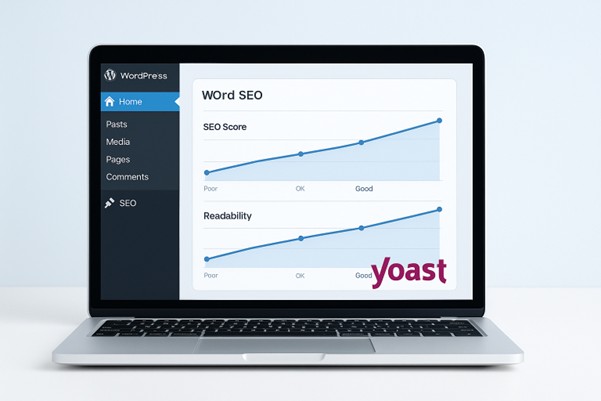If you have a WordPress website, you probably already know how important SEO is for attracting visitors and growing your business. But knowing what to do and actually doing it well are two different things. Thankfully, the Yoast SEO plugin makes the whole process much easier, even if you’re not an SEO expert. In this guide, I’ll show you how to boost your rankings using Yoast SEO without feeling overwhelmed by technical jargon.
Why SEO Matters for WordPress Sites
Search Engine Optimisation (SEO) is what helps your website appear higher in Google search results when people look for products, services, or information you offer. Better rankings mean more visibility, more clicks, and more potential customers. WordPress is a fantastic platform because it’s inherently SEO-friendly, but you still need a solid strategy to maximise your results.
That’s where Yoast SEO comes in. It’s one of the most popular WordPress plugins for a reason. It simplifies complex SEO tasks, gives you actionable suggestions, and ensures your site follows best practices without you having to dig into code.
Installing and Setting Up Yoast SEO
First things first: if you haven’t already installed Yoast SEO, go to your WordPress dashboard, click on “Plugins,” then “Add New,” and search for “Yoast SEO.” Once you install and activate it, Yoast will guide you through a basic setup wizard to configure important settings.
You’ll be asked about your site type (business, blog, online store), whether it’s operated by an individual or a company, and what your preferred site name and branding should look like in search results. Completing this setup properly sets a strong foundation for your SEO success.
Optimising Individual Pages and Posts
Once Yoast is active, you’ll see a new Yoast SEO section beneath the content editor when you create or edit a page or post. Here’s where the magic happens.
Yoast gives you a “Focus Keyphrase” field. This is the main search term you want the page to rank for. After entering your keyphrase, Yoast runs a real-time analysis and shows you what’s working and what needs improvement. It checks things like keyword usage, internal linking, readability, meta descriptions, and image alt text.
The goal is to get as many green lights as possible, but don’t obsess over making everything perfect. Sometimes aiming for 100% can lead to unnatural content. It’s better to focus on writing for humans first and search engines second.
Crafting Effective Titles and Meta Descriptions
Titles and meta descriptions are what users see in search engine results. A clear, engaging title encourages clicks, and a well-written meta description helps users understand what your page is about.
Yoast allows you to edit these easily without any coding. It also shows you a preview of how your page will appear in Google. Make sure your title includes your keyphrase, but keep it natural. Your meta description should provide a compelling reason for someone to click, ideally mentioning the keyphrase again in a natural way.
Using Readability Analysis
One of the standout features of Yoast SEO is the readability analysis. It evaluates your content for things like sentence length, paragraph structure, use of passive voice, and transition words.
Good readability isn’t just for SEO; it’s also about user experience. People are more likely to stay on your site, read more content, and take action if your writing is easy to digest.
You don’t have to follow every suggestion to the letter, but if Yoast flags that your sentences are too long or your paragraphs are too dense, it’s worth paying attention.
Setting Up a Solid Site Structure
Good SEO isn’t just about optimising individual pages; it’s about how your entire site is organised. Yoast helps you manage internal linking by reminding you to link related posts and suggesting cornerstone content — your most important, comprehensive articles.
A strong internal linking structure helps search engines understand which pages are most important and improves crawlability. It also makes it easier for visitors to navigate your site, which can boost engagement and conversions.
Managing Canonical URLs
Duplicate content can confuse search engines and hurt your rankings. Sometimes, you might have similar pages targeting the same topic. Yoast lets you set a “canonical URL” to tell Google which version of a page should be considered the original.
This is especially useful if you run an e-commerce site with multiple versions of a product page or a blog with similar articles. Managing canonical URLs properly ensures your SEO efforts aren’t diluted.
Generating an XML Sitemap
An XML sitemap is a file that lists all important pages on your website, helping search engines find and index your content faster. Yoast SEO automatically creates an XML sitemap for you and keeps it updated as you add new content.
You can find your sitemap by going to “SEO” > “General” > “Features” and clicking on the question mark next to “XML Sitemaps.” Submitting your sitemap to Google Search Console can speed up the indexing process and give you insights into how your site is performing in search.
Social Media Integration
Yoast SEO also makes it easier to optimise how your pages appear when shared on social media platforms like Facebook and Twitter. You can set custom titles, descriptions, and images for each post.
Optimising for social sharing can increase traffic from social channels and improve brand visibility. Yoast’s social features ensure your content looks polished and appealing wherever it’s shared.
Staying Updated and Ongoing Best Practices
SEO isn’t a one-time task. Search engines update their algorithms regularly, and user behavior evolves over time. That’s why it’s important to keep your WordPress site, plugins, and content updated.
Yoast SEO also regularly updates its plugin to reflect the latest SEO best practices. Keeping it up to date ensures you’re always aligned with what search engines expect.
Beyond technical updates, commit to regularly publishing high-quality, original content. Fresh content keeps your site relevant, builds authority, and gives you more opportunities to rank for different keywords.
Final Thoughts
Yoast SEO makes optimising your WordPress site much more accessible, even if you’re not an SEO expert. By using its features thoughtfully—from on-page optimisation and readability to site structure and social sharing—you can significantly boost your rankings and reach a wider audience.
Remember, SEO is a marathon, not a sprint. Consistency, quality, and attention to detail are your best friends. With Yoast SEO guiding you along the way, you’re well equipped to make meaningful progress without feeling overwhelmed.
If you’re ready to take your WordPress SEO to the next level or need personalised help, our team at Algo Digital is here for you. We specialise in technical SEO audits, content optimisation, and comprehensive SEO strategies tailored to your business needs. Our friendly, expert team based in London is committed to helping you achieve lasting growth and visibility online.
Partnering with Algo Digital means you’ll have a trusted guide at every step of your SEO journey. Contact us today to get started!



